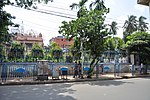Direct Action Day (16 August 1946) was the day the Muslim League decided to take "direct action" for a separate Muslim homeland after the British exit from India. Also known as the 1946 Calcutta Killings, it was a day of nationwide communal riots. It led to large-scale violence between Muslims and Hindus in the city of Calcutta (now known as Kolkata) in the Bengal province of British India. The day also marked the start of what is known as The Week of the Long Knives. While there is a certain degree of consensus on the magnitude of the killings (although no precise casualty figures are available), including their short-term consequences, controversy remains regarding the exact sequence of events, the various actors' responsibility and the long-term political consequences.Controversy still rages about the respective responsibilities of the two main communities, the Hindus and the Muslims, in addition to individual leaders' roles in the carnage. The dominant British view tends to blame both communities equally and to single out the calculations of the leaders and the savagery of the followers for whom were criminal elements. In the Congress’ version of the events, the blame tends to be squarely laid on the Muslim League and in particular on the Chief Minister of Bengal, Suhrawardy. The view from the Muslim League, which is partly upheld in Bangladesh, the successor state to East Pakistan, is that Congress and the Hindus in fact used the opportunity offered by Direct Action Day to teach the Muslims in Calcutta a lesson and to kill them in great numbers. Thus, the riots opened the way to a partition of Bengal between a Hindu-dominated Western Bengal including Calcutta and a Muslim-dominated Eastern Bengal (now Bangladesh).The All-India Muslim League and the Indian National Congress were the two largest political parties in the Constituent Assembly of India in the 1940s. The Muslim League had demanded since its 1940 Lahore Resolution for the Muslim-majority areas of India in the northwest and the east to be constituted as 'independent states'. The 1946 Cabinet Mission to India for planning of the transfer of power from the British Raj to the Indian leadership proposed a three-tier structure: a centre, groups of provinces and provinces. The "groups of provinces" were meant to accommodate the Muslim League's demand. Both the Muslim League and the Congress in principle accepted the Cabinet Mission's plan. However, the Muslim League suspected the Congress's acceptance to be insincere.Consequently, in July 1946, the Muslim League withdrew its agreement to the plan and announced a general strike (hartal) on 16 August, terming it Direct Action Day, to assert its demand for a separate homeland for Muslims in certain northwestern and eastern provinces in colonial India. Calling for Direct Action Day, Muhammad Ali Jinnah, the leader of the All India Muslim League, said that he wanted 'either a divided India or a destroyed India'.Against a backdrop of communal tension, the protest triggered massive riots in Calcutta. More than 4,000 people died and 100,000 residents were left homeless in Calcutta within 72 hours. The violence sparked off further religious riots in the surrounding regions of Noakhali, Bihar, United Provinces (modern Uttar Pradesh), Punjab and the North Western Frontier Province. The events sowed the seeds for the eventual Partition of India.





